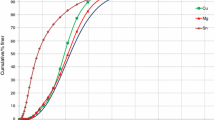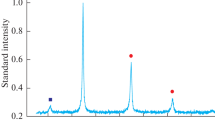Abstract
The structure and mechanical properties of Al-Li8090 alloy, that was dynamically deformed and then age hardened, were studied as a function of the changes in the nature and amount of precipitates produced. A comparison was made between two groups of samples, one group that was solution heat treated (SHT) and quenched from 530°C before the dynamic deformation and the other group that was dynamically deformed in the as-received (AR) condition. The higher values for microhardness and ultimate tensile strength observed (138 and 140 VHN, and 405 and 458 MPa, respectively), subsequent to shock treatment (ST), have been attributed to the increase in dislocation density and grain-boundary precipitation produced due to shock deformation. Dislocations and grain boundaries were assumed to act as precipitation sites and an increase in dislocation density, due to ST, was expected to increase precipitation density of δ′(Al3Li), S(Al2CuMg), and T1(Al2CuLi) phases which, in turn, are expected to increase strength properties of the alloy. Differential scanning calorimetry showed that, for the species that precipitate below 180°C, δ′(Al3Li) and GP zones, an increase in the amount of deformation increased the precipitation temperatures. However, for the species that precipitate at 197°C, S(Al2CuMg), an increase in the amount of deformation produced a decrease in its precipitation temperature. These results have been partially confirmed by the activation energy calculations for temperatures below 197 °C, which show a decrease of precipitation energies with an increase in the amount of deformation. Activation energies calculated from ageing curves showed that when ageing at low temperature (165–180 °C range), activation energies for the precipitation process are decreased upon increase in cold work. Shock treatment of SHT samples exhibited decreased activation energy values of precipitation, from 36.14 kcal mol−1 for the SHT sample to 24.18, 24.08, and 21.00 kcal mol−1 for SHT + ST samples 1, 2, and 3, respectively (corresponding to 1, 2, and 3 sheets of explosive). Activation energies of precipitation for AR + ST samples showed even lower values; 9.45, 9.95, and 8.21 kcal mol−1 for samples 4, 5, and 6, respectively. These activation energies strongly corroborate the role of defect substructure on the age-hardening kinetics of this alloy.
Similar content being viewed by others
References
P. J. Bischle and J. W. Martin, in “Proceedings of the 4th International Conference on Al-Li”, edited by G. Champier and B. Dubost (Les Editions, Paris, France, 1987) p. 761.
A. F. Smith, ibid“, p. 49.
M. Nunomi and K. Degawa, ibid.“ p. C3–653.
A. Polato, in “Proceedings of the 12th Annual Symposium on Behavior and Utilization of Explosives in Engineering Design”, edited by L. Davison, J. E. Kennedy and F. Coffey (ASME, Alburquerque, NM, 1972) p. 25.
E. A. Starke and T. H. Sanders, J. Metals 33 (1981) 24.
A. K. Mukhopadhyay, C. N. Tite, H. M. Flower, P. J. Gregson and F. Sale, in “Proceedings of the 4th International Conference on Al-Li”, edited by G. Champier and B. Dubost (Les Editions, Paris, France, 1987) p. 439.
S. Avis, E. Evangelista, P. Mengucci and G. Riontino, ibid.“, p. 447.
W. S. Miller, J. White and D. J. Lloyd, ibid.“ p. 447.
S. Suresh and A. K. Vasudevan, in “Proceedings of the 3rd International Al-Li Conference”, edited by T. Sheppard (Institute of Metals, London, 1986) p. 595.
L. E. Murr, O. T. Inal and A. A. Morales, Acta Metall. 24 (1985) 268.
Alfred H. Geisler, “Phase transformations at interfaces” (ASM, Cleveland, OH, 1952), p. 269.
Donald R. Askeland, “The science and engineering of materials” (PWS-Kent Co, Boston, MA, 1989) p. 118.
J. White, W. S. Miller, I. G. Palmer, R. Davis and T. S. Saini, in “Proceedings of the 3rd International Al-Li Conference”, edited by T. Sheppard (Institute of Metals, London, 1986) p. 425.
R. F. Ashton, D. S. Thompson, E. A. Starke and F. S. Lin, in “Proceedings of the 3rd International Al-Li Conference”, edited by T. Sheppard (Institute of Metals, London, 1986) p. 66.
K. Welpman, M. Peters, T. H. Sanders, ibid.“, p. 524.
R. F. Ashton, D. S. Thompson, E. A. Starke and F. S. Lin, ibid.“, p. 74.
Author information
Authors and Affiliations
Rights and permissions
About this article
Cite this article
Esquivel, R., Inal, O.T. Characterization of shock-hardened Al-8090 alloy. JOURNAL OF MATERIALS SCIENCE 30, 5825–5832 (1995). https://doi.org/10.1007/BF00356728
Received:
Accepted:
Published:
Issue Date:
DOI: https://doi.org/10.1007/BF00356728




